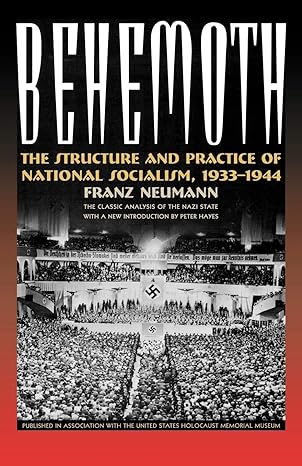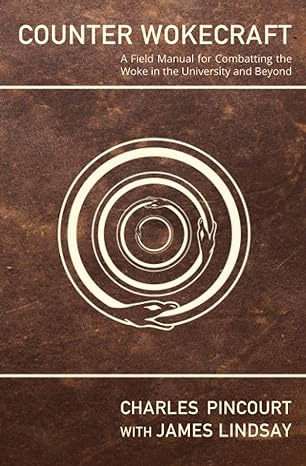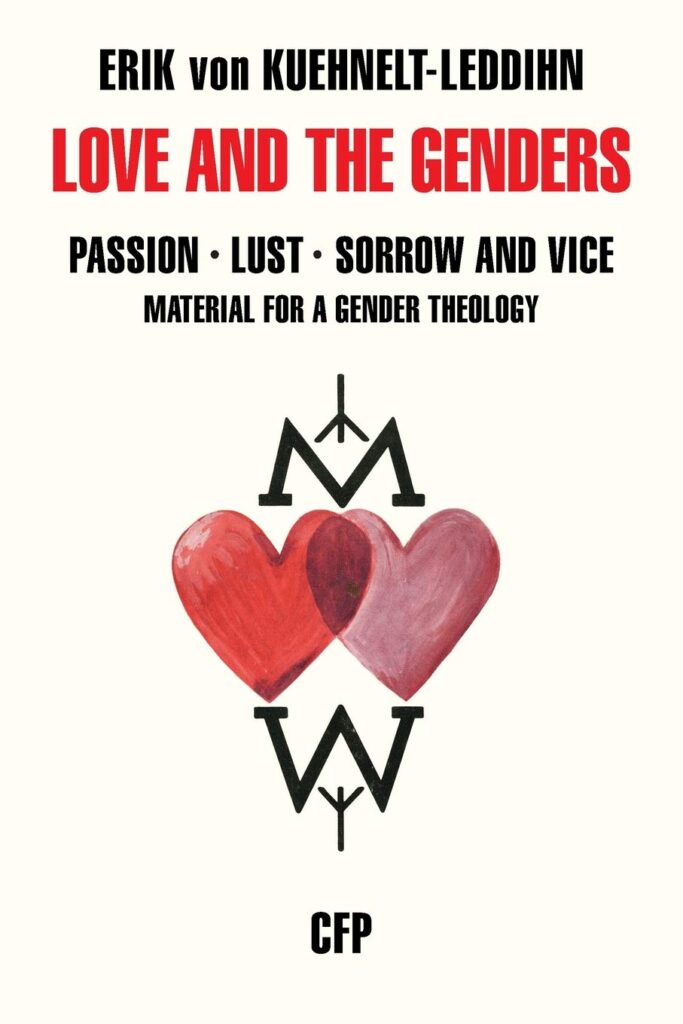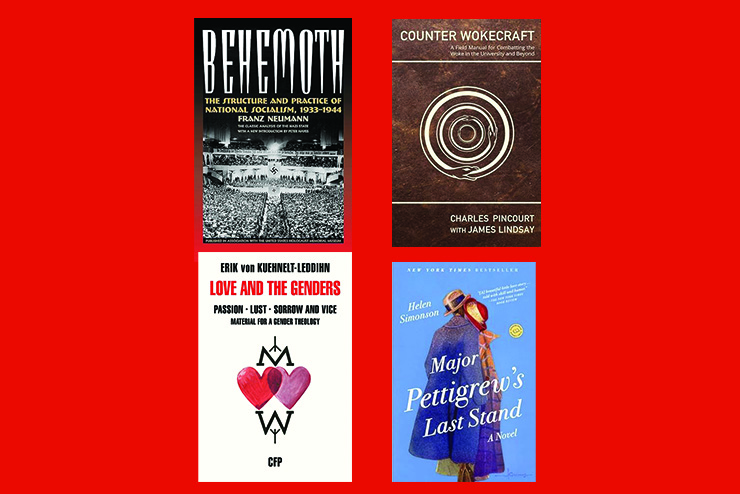
The equation of Western civilization with fascism, racism, and genocide is now de rigueur within most leftist circles. Yet there was a time when the most radical members of the left rejected this false conflation. Franz Neumann’s 1944 study Behemoth: The Structure and Practice of National Socialism, 1933-1944 exemplifies a leftist scholarly tradition that now belongs to a bygone age. Notwithstanding his affiliation with the Frankfurt School and his spying for the Soviet Union during World War II, Neumann’s Behemoth should be valued for its considerable merits.
Although Neumann analyzes the Nazi regime from a Marxist perspective, he generally avoids the economic reductionism that typically characterizes this ideology. He rejects the claim that National Socialism was “merely a subservient tool of German industry.” At most, the regime and German capitalists shared “identical interests,” particularly the destruction of the labor movement and the imperialist expansion of German Lebensraum.
In sharp opposition to the thesis of James Burnham’s The Managerial Revolution (1941), Neumann shows that the managerial elites in government and business did not abolish capitalism, despite the Nazi usage of pseudo-socialist rhetoric. Notwithstanding real tensions between the regime and big business, the cement that always bound them together was “profit, power, and, above all, fear of the oppressed masses.”
Neumann also defends “liberal ideas of freedom and equality” that the Weimar Republic desperately tried to uphold in the face of withering attacks from the far left and right. Besides his sympathy for bourgeois order, Neumann is bound to disappoint today’s woke left on other grounds as well. While condemning the “pseudo-egalitarianism” of the Nazis, he credits the Prussian officer corps for retaining “some of the more decent characteristics of feudalism, the longing for culture, even though dilettante, for comradeship and faith.”
Neumann does not sound like a typical representative of the Frankfurt School when he portrays the Nazi regime as anti-Christian. Christian counterrevolutionaries such as Burke, De Maistre, Bonald, and Cortes, who opposed the radical left in their time, were not forerunners of Nazism given their shared view that a legitimate state must be based on the rule of law, not terror. Additionally, their Augustinian focus on the sinfulness of all human beings was hardly the basis for the Nazi idolization of an omnipotent leader.
Neumann’s Behemoth is a sobering reminder of a time when leftist scholars displayed a fair-minded attitude to political phenomena that did not necessarily reflect their biases.
—Grant Havers

This is a much-needed field guide for understanding and combatting wokeism within academia and beyond. Charles Pincourt explains in Counter Wokecraft the “woke” worldview, called Critical Social Justice (CSJ), which encompasses a set of disciplines that start with the assumption that some group is unjustly oppressed.
CSJ further presupposes that knowledge of objective reality is fundamentally impossible, since access to reality is always socially constructed and that knowledge “is constructed in such a way that it helps the oppressive role of the oppressor groups.” By assuming that oppression is omnipresent, CSJ urges everyone to locate and overthrow these oppressive structures in service of ever-expanding equity.
Some of the tactics woke proponents use to advance CSJ include “problematizing” cultural norms, introducing woke terms, insisting on informality, emphasizing emotion, never letting things go, demanding charity but never extending it, misinterpreting, piling on, obfuscating, canceling, de-platforming, and advancing extreme claims by conflating them with uncontroversial ones. Pincourt rightly notes that these tactics largely succeed on account of the assumptions of tolerance, charity, and good faith non-woke actors naïvely extend to their woke interlocutors.
The set of prescriptions Pincourt offers to combat these woke dark arts include encouraging non-woke actors to take CSJ seriously and to be vigilant in countering it before it gains institutional traction. Additionally, Pincourt advises non-woke actors to call out CSJ whenever possible, organize with non-woke allies, prioritize non-woke interventions, ensure dissident representation, and vote.
Counter Wokecraft succeeds in making explicit the tactics wokesters use to commandeer academia so effectively and offers useful countertactics. Yet Pincourt’s prescriptions ultimately amount to a set of tactics without a grand strategy. In his conclusion, he states, “We want to bring universities back towards a liberal, universal, Enlightenment mission.” Conservatives will part ways with Pincourt here. The roots of Western civilization go much deeper than Enlightenment liberalism—to Christian-Aristotelianism, natural law, patriarchy, family, and heritage—and only a proper restoration of those roots can provide the kind of telos able to oppose wokeism.
—Michael Robillard

This posthumous book by Erik von Kuehnelt-Leddihn, whom William F. Buckley called, defensibly, “the world’s most fascinating man” is a stunningly erudite contribution to the defense of long-known truths about the human sexes and their relations.
Kuehnelt-Leddihn, a polymath who wrote a tremendous amount on a breathtakingly wide array of topics, has read more deeply into the full range of world civilizational traditions on sex, gender, and love than most of his potential readers could hope to manage in three lifetimes. This work is a philosophical exploration of truths concerning human sexuality and love, both material and spiritual, that must be known and taught by any civilization that would call itself Christian. It is both a contribution to scholarship and a practical guidebook, with invaluable troves of advice backed by deep theological reflection and historical study.
One finds vividly lyrical passages on marriage and its capacity, in the Christian framework, to produce an elegant, miraculous “Mixtum Compositum” of sexuality, eros, philia, and agape. Even in its comparatively weak cases, Christian marriage hews two souls together in “a deep togetherness, created through time and closeness… [wherein] something always remains hidden, secret, strange, incomprehensible for the outsider.” The future of Western civilization depends on the defense of this invaluable form of human love.
The breadth of Kuehnelt-Leddihn’s knowledge is perhaps most in evidence in the extensive notes. They make up in themselves a short book in length, about 160 pages, nearly as many as the main text. Even a casual perusal of those notes turns up profundities. Here are but a few such gems with indications of sources: Humanity is made up of men and women but in its essence “it is a mother” (M. Unamuno). Men are in an essential way more vulnerable than women in love because they can never be certain that their children are theirs. Hence the horrific story of the mother who murdered her own child being condemned on the scaffold by her husband, who had adored the dead girl, and sneering monstrously at him, “Don’t grieve, my dear, Jeanette was not yours.” Marital love is both the most perfect form of happiness on Earth (I. Turgenev) and “tortuous and tragic,” as recognized by the Eastern Orthodox Church’s tradition of holding a martyr’s crown over the heads of bride and groom during the wedding ceremony (N. Berdyaev); “To love a person means telling him: you will never die” (G. Marcel).
Kuehnelt-Leddihn joyfully reminds us that “love and especially the love between the genders [is] one of the few lights in the darkness” of the mournful fog of our contemporary sexual culture.
—Alexander Riley

For two centuries the novel of manners, while bringing high-level reading pleasure, also served a social purpose by examining human types and classes. Famous examples include works by Jane Austen, Stendhal, William Thackery, Honoré de Balzac, Henry James, and Edith Wharton. Drawing on keen powers of observation and knowledge of human nature, these novelists depicted mores, characters, and follies of stratified societies and proposed appropriate standards of conduct and corrective measures.
Tremendous cultural and social changes have by now diminished somewhat the taste for the genre. Yet its rich possibilities keep their appeal for many readers. In her 2010 novel Major Pettigrew’s Last Stand, Helen Simonson has used its conventions well in a contemporary context. She is skilled in plotting and her sensitive portraits are tactful, instructive, and moving, as well as entertaining.
The setting is a village near the English Channel. The principal figures, some traditional types, include a widower, Major Pettigrew, retired; his covetous sister-in-law; and Roger, his foolish and pretentious son. Then there are outsiders among the villagers: Roger’s manipulative American girlfriend, Sandy; a greedy, arrogant arriviste land developer, likewise from the U.S.; and the new village shopkeepers, of Pakistani descent.
Chance, which plays a role within even small social circles, leads the major to meet and develop an acquaintance with one of the shopkeepers, Mrs. Jasmina Ali, also widowed. The two have much in common, especially devotion to British poetry. As in the canonic novel of manners, these two characters cannot cross certain lines without social penalty. While older obstacles have partly disappeared, xenophobia, youthful rebellion, illegitimacy in Jasmina’s extended family, and religious fanaticism create barriers to the lovers’ happiness. Will the winds of fortune, so contrary to the couple, turn in their favor?
This is Britain as it is, not as it was or one might wish it. After more than 60 years, social tensions and disorder, attributed to its colonial past and its immigrant present, persist. Such are the legacies of history. But it was England that allowed Jasmina’s father and many others to become Englishmen, cherishing its political institutions, national character, and language; and it protects her and makes her fit to be an Englishman’s wife. The generous benefits of Western civilization may include romance.
—Catharine Savage Brosman

Leave a Reply